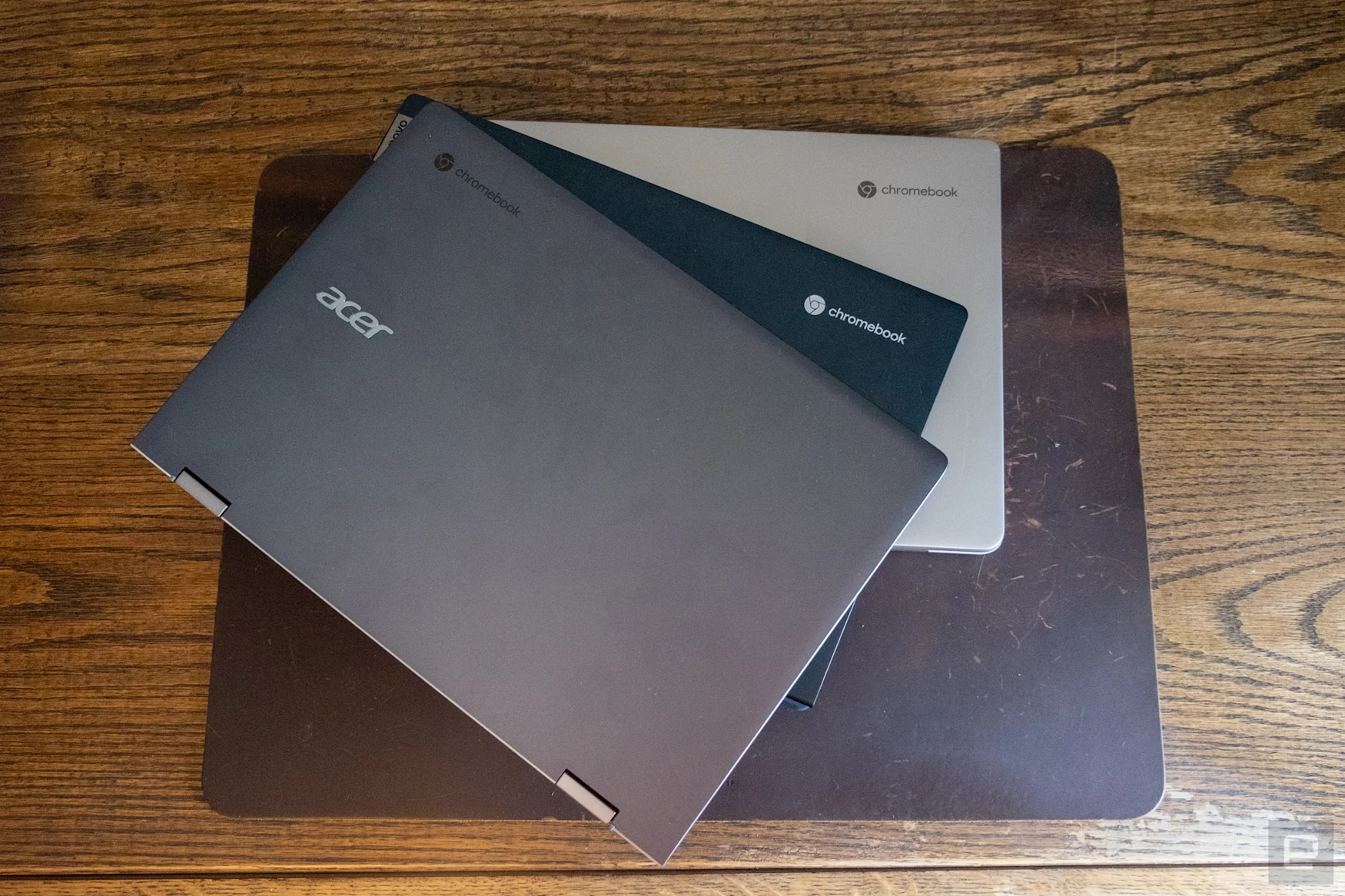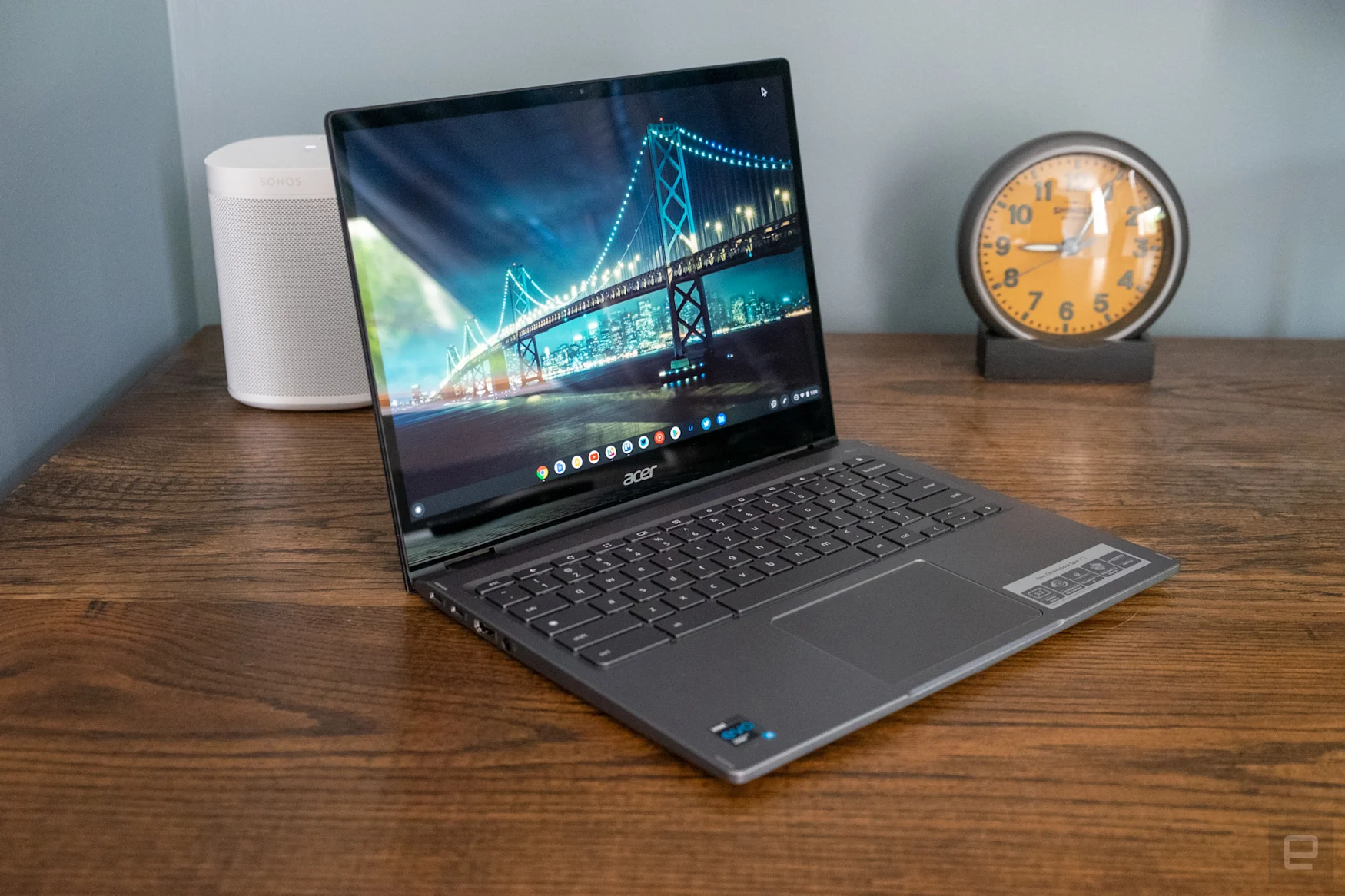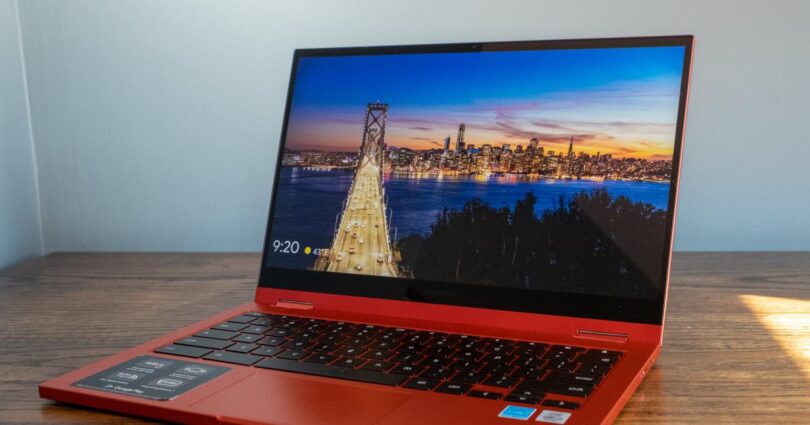Choosing the best Chromebook for you, given your needs and your budget, can be hard to do given the plethora of models on the market today. The combination of years worth of software updates and laptop manufacturers making more powerful and better-built laptops means there are a ton of good Chrome OS machines that work well as everyday drivers. But there are some special factors to Chromebooks that you should keep in mind before choosing one. We’ll help you figure out what is the best Chromebook for you, from the Lenovo IdeaPad Flex 5i to the Acer Chromebook Spin 714 and in between.
What is Chrome OS, and why would I use it over Windows?
That’s probably the number one question about Chromebooks. There are plenty of inexpensive Windows laptops on the market, so why bother with Chrome OS? Glad you asked. For me, the simple and clean nature of Chrome OS is a big selling point. Chrome OS is based on Google’s Chrome browser, which means most of the programs you can run are web based. There’s no bloatware or unwanted apps to uninstall like you often get on Windows laptops, it boots up in seconds, and you can completely reset to factory settings almost as quickly.
Of course, the simplicity is also a major drawback for some users. Not being able to install native software can be a dealbreaker if you’re a video editor or software developer. But there are also plenty of people who do the majority of their work in a browser. Unless I need to edit photos for a review, I can do my entire job on a Chromebook.
Google has also added support for Android apps on Chromebooks, which greatly expands the amount of software available. The quality varies widely, but it means you can do more with a Chromebook beyond just web-based apps. For example, you can install the Netflix app and save videos for offline watching. Other Android apps like Microsoft Office and Adobe Lightroom are surprisingly capable, as well. Between Android apps and a general improvement in web apps, Chromebooks are more than just a browser.
What do Chromebooks do well?

Nathan Ingraham / Engadget
Put simply, anything web based. Browsing, streaming music and video and using various social media sites are among the most common daily tasks people do on Chromebooks. As you might expect, they also work well with Google services like Photos, Docs, Gmail, Drive, Keep and so on. Yes, any computer that can run Chrome can do that too, but the lightweight nature of Google Chrome OS makes it a responsive and stable platform.
As I mentioned before, Chrome OS can run Android apps, so if you’re an Android user you’ll find some nice ties between the platforms. You can get most of the same apps that are on your phone on a Chromebook and keep info in sync between them. You can also use some Android phones as a security key for your Chromebook or instantly tether your laptop to use mobile data.
Google continues to tout security as a major differentiator for Chromebooks, and I think it’s definitely a factor worth considering. The first line of defense is auto-updates. Chrome OS updates download quickly in the background and a fast reboot is all it takes to install the latest version. Google says that each webpage and app on a Chromebook runs in its own sandbox, as well, so any security threats are contained to that individual app. Finally, Chrome OS has a self-check called Verified Boot that runs every time a device starts up. Beyond all this, the simple fact that you generally can’t install traditional apps on a Chromebook means there are a lot fewer ways for bad actors to access the system.
As for when to avoid them, the answer is simple: If you rely heavily on a specific native application for Windows or a Mac, chances are you won’t find the exact same option on a Chromebook. That’s most true in fields like photo and video editing, but it can also be the case in law or finance. Plenty of businesses run on Google’s G suite software, but more still have specific requirements that a Chromebook might not match. If you’re an iPhone user, you’ll also miss out on the way the iPhone easily integrates with an iPad or Mac. For me, the big downside is not being able to access iMessage on a Chromebook.
Finally, gaming is mostly a non-starter, as there are no native Chrome OS games of note. You can install Android games from the Google Play Store, but that’s not what most people are thinking of when they want to game on a laptop. That said, Google’s game-streaming service Stadia has changed that long-standing problem. The service isn’t perfect, but it remains the only way to play recent, high-profile games on a Chromebook. It’s not as good as running local games on a Windows computer, but the lag issues that can crop up reflect mostly on Stadia itself and not Chrome OS.
There’s also a potential change on the horizon in that regard, as Valve and Google are working to bring the massive Steam catalog to Chromebooks. Right now, Steam is only available as an early alpha on a handful of devices with higher specs, but it works a lot better than I expected. Of course, you’re still not going to run the most demanding games on basic laptops, but the Steam catalog is so vast that there are plenty of titles that worked on the Chromebook I tested it with. Maybe by next year, Steam will be supported on more devices.
What are the most important specs for a Chromebook?

Nathan Ingraham / Engadget
Chrome OS is lightweight and usually runs well on fairly modest hardware, so the most important thing to look for might not be processor power or storage space. That said, I’d still recommend you get a Chromebook with a relatively recent Intel processor, ideally an eighth-generation or newer M3 or i3. Most non-Intel Chromebooks I’ve tried haven’t had terribly strong performance, but that’s starting to change. Lenovo’s Chromebook Duet 2-in-1 from 2021 runs surprisingly well on its MediaTek processor.
As for RAM, 8GB should be the target, unless you’re looking for a budget model and know that your needs are fairly modest. Storage space is another place where you don’t need to spend too much; 64GB should be fine for almost anyone. If you plan on storing a lot of files locally or loading up your Chromebook with Linux or Android apps, get 128GB. But for what it’s worth, I’ve never felt like I might run out of storage when using Chrome OS.
Things like the keyboard and display quality are arguably more important than sheer specs. The good news is that you can find less expensive Chromebooks that still have pretty good screens and keyboards that you won’t mind typing on all day. Many cheap Chromebooks still come with tiny, low-resolution displays, but at this point there’s no reason to settle for anything less than 1080p. (If you’re looking for an extremely portable, 11-inch Chromebook, though, you’ll probably end up with a lesser screen.) Obviously, keyboard quality is a bit more subjective, but there are plenty of affordable options that offer strong typing experiences.
Google has an Auto Update policy for Chromebooks, and while that’s not a spec, per se, it’s worth checking before you buy. Basically, Chromebooks get regular software updates automatically for about six years from their release date (though that can vary from device to device). This support page lists the Auto Update expiration date for virtually every Chromebook ever, but a good rule of thumb is to buy the newest machine you can to maximize your support.
How much should I spend?
Chromebooks started out notoriously cheap, with list prices often coming in under $300. But as they’ve gone more mainstream, they’ve transitioned from being essentially modern netbooks to the kind of laptop you’ll want to use all day. As such, prices have increased a bit over the last few years. At this point, you should expect to spend at least $400 if you want a solid daily driver. There are still many budget options out there that may be suitable as couch machines or secondary devices, but Chromebooks that can be an all-day, every-day laptop will cost a bit more.
There are also plenty of premium Chromebooks that approach or even exceed $1,000, but I don’t recommend spending that much. Generally, that’ll get you a better design with more premium materials, as well as more powerful internals and extra storage space. Of course, you also sometimes pay for the brand name. But, the specs I outlined earlier are usually enough.
Right now, there actually aren’t too many Chromebooks that cost that much. The Google Pixelbook Go comes in $999 and $1,399 configurations, but the more affordable $650 and $850 options will be just as good for nearly everyone. Samsung released the $1,000 Galaxy Chromebook in 2020; this luxury device does almost everything right but has terrible battery life. Samsung quickly learned from that mistake and is now offering the Galaxy Chromebook 2 with more modest specs, but vastly better battery life at a more affordable price . For the most part, you don’t need to spend more than $850 to get a premium Chromebook that’ll last you years.
See Also:
Best overall: Lenovo IdeaPad Flex 5i
Lenovo has been making some of the best Chromebooks you can buy for several years now and, more recently, it has once again made the best option for most people. The IdeaPad Flex 5i Chromebook is essentially an upgraded version of the model we recommended last year, and there are a few notable improvements. The 13.3-inch, 1080p touchscreen is extremely bright and fairly sharp; I wish it had a taller aspect ratio than 16:9, but this type of screen is very commonplace in Chromebooks. This Lenovo Chromebook runs on a 11th-generation Intel Core i3 processor and includes 8GB of RAM and 128GB of storage; both of those are double what last year’s model offered. Eight hours of battery life is pretty good for a laptop in this price range, and the backlit keyboard is excellent for such an affordable device. The key caps feel a little small under my fingers, but that’s the only real complaint I have.
The Lenovo Flex 5i is no longer available directly from Lenovo, but you can commonly find it on Amazon for about $400 (as of this writing, it is selling for $409; when I bought it, it was priced at $390). That’s an outstanding value.
Other things in the Flex 5i’s favor include that it has both USB-C and USB-A ports, a microSD card slot and a security lock. At three pounds and 0.66 inches thick, it’s not the lightest or slimmest option out there, but it’s totally reasonable considering the price. Finally, the Flex 5i will receive software and security updates until June of 2029, so you can buy this computer and have it covered for years to come.
Ultimately, the Ideapad Flex 5i hits the sweet spot for a large majority of Chromebook buyers out there, providing a level of quality and performance that’s pretty rare to find at this price point. That said, given this laptop has been out for over a year now, we’re keeping an eye out for a replacement from Lenovo, as well as comparable options other manufacturers release.
One to look out for is Lenovo’s Chromebook 5i, which the company recently released. Right now, it’s only available with an Intel Pentium Gold processor and 4GB of RAM; in my testing, that wasn’t enough power by modern standards. The device froze up far too often, and the IdeaPad Flex 5i with its i3 processor was clearly faster at everything I tried. But Lenovo says it’ll offer the Chromebook 5i with up to an Intel i5 processor, which should make the laptop worth checking out.
Upgrade option: Samsung Galaxy Chromebook 2
Last year, Samsung’s Galaxy Chromebook 2 was one of my recommendations for people looking for a more premium Chromebook. Now that Samsung often sells the device for $550, it’s an excellent all-purpose recommendation if you want something more svelte and stylish than Lenovo’s IdeaPad Flex 5i.
The Galaxy Chromebook 2 is infinitely more stylish than most other Chromebooks, with a bright metallic red finish and sleek design. This Samsung Chromebook 2 fixes some of the serious flaws we identified in the original Galaxy Chromebook. Specifically, the 2020 Galaxy Chromebook had terrible battery life and cost $999; this year’s model can be found for $550 and can last seven hours off the charger. That’s not great, but it’s far better than the lousy four hours the original offered.
Samsung cut a few corners to lower the Galaxy Chromebook 2’s price. Most noticeable is the 1080p 13.3-inch touchscreen, down from the 4K panel on the older model. The good news is that the display is among the best 1080p laptop screens I’ve seen in a long time, and the lower resolution helps the battery life, too. Along with that excellent screen, the device also has a very comfortable keyboard, though I wish the trackpad was a little bigger. The Galaxy Chromebook 2 is also a bit thicker and heavier than its predecessor, but it’s still reasonably compact. At 13.9mm thick and 2.7 pounds, it’s noticeably smaller than the Lenovo.
The Galaxy Chromebook 2 has a 10th-generation Intel Core i3 processor paired with 8GB of RAM and 128GB of storage, which is plenty. This all adds up to a laptop that isn’t as ambitious as the first Galaxy Chromebook, but one that is much easier to recommend. Instead of pushing to have the best screen in the thinnest and lightest body with a faster processor, Samsung pulled everything back a bit to make a better-priced but still premium Chromebook laptop. Given that the Galaxy Chromebook 2 is well over a year old now, I wouldn’t recommend spending $700 on it – but if you can catch it on sale for $550 (as it is right now), it’s a solid option.
Read our Full Review of Samsung Galaxy Chromebook 2
Premium option: Acer Chromebook Spin 714
Acer’s Chromebook Spin 714 is an evolution of the Spin 713 that I recommended last year. Acer made a few tweaks to the formula, but you’re still getting a well-built, powerful laptop that won’t turn any heads with its design but gets the job done well.
I loved the display on the Acer Chromebook Spin 713, and unfortunately the one on the Spin 714 isn’t quite as exciting. It’s a 14-inch, 1900×1200 touchscreen; that works out to a taller 16:10 aspect ratio than you’ll get from the 1080p panels on most other premium Chromebooks. I’m a big fan of taller laptop screens – but the Spin 713 had a 13.5-inch screen that had an even taller 3:2 aspect ratio and a higher resolution. I can’t help but wonder if Acer found that people still prefer a widescreen display. If that’s the case, the Spin 714’s display is a nice middle ground.
Putting aside these comparisons to last year’s model, the Acer Spin 714’s screen is still very nice – it can get uncomfortably bright if that’s your thing, and the bezels are thin. It’s not nearly as pixel-dense as the Spin 713, but it’s still plenty sharp. Between the extra vertical height and the slightly larger screen size, the Spin 714’s display is a pleasure to use.
As for the rest of the hardware, the 12th-generation Intel Core i5 processor is more than enough power for most everyday tasks, and the keyboard and trackpad are solid, if not the best I’ve used before. The same can be said for battery life: I got about seven hours using the Spin 714 in my normal daily routine – not exceptional, but in line with what I’ve seen on other Chromebooks with an i5 processor. Rounding out the hardware is 8GB of RAM and a generous 256GB of storage space. From a support perspective, Google will offer software and security updates until June of 2030.
Another bonus is that its hardware meets Google’s recommended specs to run Steam, though the alpha build is still limited to seven devices. So while it’s not officially supported yet, Steam will hopefully work on this laptop once Google and Valve start rolling it out more widely.
Just as the name suggests, the Spin 714 has a 360-degree hinge which lets you use the laptop in tablet mode. I’m not particularly a fan of this convertible design – I don’t know who wants to use a 3-plus pound tablet, but Acer did include a built-in stylus for handwriting notes or drawing in apps like the built-in Chrome Canvas.
The Spin 714 configuration I tested costs $730 – that’s a lot of money for even a high-end Chromebook. But it’s not an unreasonable price for a computer with these specs and built quality. For most people, the Lenovo will be enough. But, if you’re a serious multitasker, want a better display and keyboard, or just want a computer that’ll last as long as possible, the Acer Spin 714 is easy to recommend.





